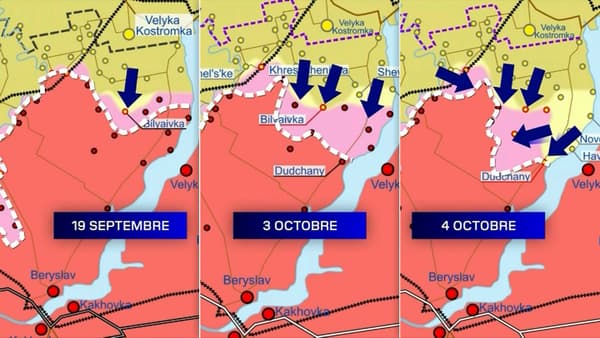As soon as annexed, as soon as taken? While Vladimir Putin officially signed last week the annexation of four regions of Ukraine to Russia after false referendums, one of them, that of Kherson, is currently the scene of a rapid counteroffensive by the Ukrainian forces that chained the victories there. .
On Tuesday, Ukrainian President Volodymyr Zelensky called for “powerful” advances in the area, referring to “dozens” of towns seized. Earlier, a military map presented by the Russian Defense Ministry during its daily briefing showed a significant withdrawal of Russian forces and shows soldiers leaving a large number of towns, including Dudchany, on the West Bank of the Dnieper River. To date, the front is about sixty kilometers north of Kherson.
Symbolic and geographical importance
A potential reconquest of the city of Kherson would have a strong symbolic meaning. Since the first days of the conflict, the city – which had just under 300,000 inhabitants at the beginning of the year – had been subjected to intense bombardment. It had been conquered in early March by Moscow.
It is, since the start of the “special military operation”, the only significant capture by Kremlin soldiers and the largest city still controlled by Russia.
“This is the only administrative capital occupied by the Russians since the beginning of the invasion,” Oleskiy Goncharenko, a Ukrainian parliamentarian from the Odessan constituency, told BFMTV on Wednesday.
Geographically, this port city is a great challenge for Russia. Located near the Ukrainian peninsula of Crimea annexed in 2014, it allows both to control access to the Sea of Azov, as is also the case with Mariupol, and to create a “buffer zone” between the current Ukrainian territory and the Donbass region.
Kherson is also an open door directly to Russia. Following the annexation of Crimea, Russia quickly built a bridge over the Kerch Peninsula, connecting Russian territory with the latter. To the west, the other end of Crimea is connected to the Kherson region by the Perekop Isthmus, which allows it to ensure the supply of its troops directly from its lands.
The Russians caught in a pincer movement?
Despite the impressive advances of the Ukrainian forces, the recapture of Kherson is far from complete. Currently, between 15,000 and 25,000 Russian soldiers are still in the city “which has become totally fortified and with elite troops inside,” explains Patrick Sauce, international political columnist for BFMTV, who points out that in recent weeks, Kyiv used “the Russian gaps that opened up and got bigger and bigger”.
For Kyiv, the goal now is to take back Kherson without fighting within it so as not to endanger the citizens who are still there. According to General Jérôme Pellistrandi, a defense consultant for BFMTV, the best card the Ukrainians can play is to take the Russian soldiers in a pincer movement, as was successfully done at Lyman.

“There are these soldiers blocked on the right bank of the city. The goal of the Ukrainians is to continue this offensive along the Dnieper River to avoid fighting in the city. If the Russians go down, they will have to cross the river at some point.” point”, he describes. However, in September, during strategic attacks, the Ukrainian army destroyed several bridges connecting the two shores of the city, preventing any escape.
“The Ukrainians are going to have to be smart”, Patrick Sauce summarizes, but “if the mouth of the Dnieper jumps, the rest can leave very quickly in the direction of Crimea”, he adds.
Moscow’s apathy in response
Vladimir Putin warned that “if Russia’s national interests are ever threatened”, then the country will be able to use “all weapons at its disposal”, again leaving the use of nuclear weapons in Ukraine. However, since the referendums at the end of September recognized only by Moscow, the Kherson region is for Moscow a Russian entity in its own right, although the borders are not yet clearly defined.
Faced with the Ukrainian advance, will Vladimir Putin be able to carry out his threats, he who is pushed by several of his relatives, including the Chechen leader Ramzan Kadyrov, to use stronger means? “This is the big threat and Putin can consider this possibility. But it would be suicide for Russia”, doubts the elect Oleskiy Goncharenko, still on our antenna.
It is clear that since the beginning of the Ukrainian counteroffensive, the Russian military seems apathetic and largely overwhelmed by events. “It is a post-Soviet political-military system incapable of showing flexibility, it is the collapse of this system”, describes Jérôme Pellistrandi.
Thus, as is often the case when it suffers a setback, the Russian army employs the “scorched earth” strategy and tries to attack in all directions. However, Russian ammunition stockpiles are dwindling and the general staff is forced to turn to Iranian-made equipment, including drones, to respond. On Tuesday a person was injured by one of them in the Kyiv region, a very light response given the debacle that the Russian army is currently experiencing.
“You can draw a parallel to history, the famous V1s and V2s that Hitler used, supposedly to shake up the war. They seem to be trying to do what they can to keep up the pressure, but the point of reality is that the Russians are in defensive and that they are forced to withdraw to the Kherson region”, concludes General Pellistrandi.
Source: BFM TV

